Marketing Audit and Segmentation for Marks & Spencer: A Report
VerifiedAdded on 2021/01/01
|13
|4174
|28
Report
AI Summary
This report presents a marketing audit of Marks & Spencer, examining its current performance, marketing strategies, and market position. The introduction defines marketing and its processes, including research, targeting, segmentation, and promotion. Task 1 conducts a comprehensive marketing audit, emphasizing the need for systematic, independent, and periodic evaluations. It analyzes M&S's shift to local market focus, its word-of-mouth marketing, and the use of demographic and psychographic segmentation. The report highlights M&S's position in the UK retail market, its revenue growth, and customer perception. It also discusses how demographic variables like income and occupation are used for segmentation, along with the buyer's decision-making process, including need recognition, information research, and the buying experience. The report concludes by exploring how understanding customer demographics can help M&S grow within the retail industry, including tactics like social media advertising and creating valuable content.

Marketing
Paraphrase This Document
Need a fresh take? Get an instant paraphrase of this document with our AI Paraphraser

TABLE OF CONTENTS
INTRODUCTION...........................................................................................................................1
TASK...............................................................................................................................................1
1.1 A marketing audit of the business’s current performance and an evaluation of the
organisations current marketing strategy and position in the market.........................................1
CONCLUSION................................................................................................................................9
REFERENCES..............................................................................................................................10
INTRODUCTION...........................................................................................................................1
TASK...............................................................................................................................................1
1.1 A marketing audit of the business’s current performance and an evaluation of the
organisations current marketing strategy and position in the market.........................................1
CONCLUSION................................................................................................................................9
REFERENCES..............................................................................................................................10

INTRODUCTION
Marketing is the activity of business in which marketers promote and sell their products
and services, which includes research and advertising. This activity is done to satisfy customers
(Armstrong, Kotler and Brennan, 2015). It is the process in which a product is brought in the
market which includes researching, targeting market, segmentation, pricing, strategies for
promotion, etc. Marketing audit means investigation and analysis of marketing activities,
objectives and goals. The audit must be comprehensive i.e. it should cover all areas, systematic,
independent, and periodical.
Mark & Spencer Group is a multinational retailer company in London, United Kingdom
founded in the year 1884 by Michael Marks and Thomas Spencer. The company deals in the
selling of clothes, home ware products, and luxury food items. It also started selling branded
products like Kellogg's Corn Flakes in 2008. This report will undertake a marketing audit of the
business's current performance and evaluation of organisation's external strategies and position in
the market. Apart from this, it will cover two sets of marketing segmentation to be proposed for
successful targeting of the market. And lastly, it will show how the chosen customer group will
grow the business within the retail industry.
TASK
1.1 A marketing audit of the business’s current performance and an evaluation of the
organisations current marketing strategy and position in the market.
The broad, systematic, analysis, assessment and interpretation of the business e
situations, its objectives, goals, strategies, etc. is known as marketing audit. It determines various
defects, problems, internal and external marketing environment and compares marketing plans of
the company with its actual performance. Marketing audit is basically conducted by the third
person and not a member of the company. Any organisation, conducting a marketing research
must keep some key points in mind such as: -
Comprehensive: Marks & Spencer marketing audit must be such that it should cover all
the areas of marketing, those areas where the problem prevails (Mullakhmetov and
Akhmetshin, 2016).
Systematic: The audit must be systematic, i.e. the analysing and evaluation of micro and
macro factors, objectives, marketing principles, strategies and other activities that
1
Marketing is the activity of business in which marketers promote and sell their products
and services, which includes research and advertising. This activity is done to satisfy customers
(Armstrong, Kotler and Brennan, 2015). It is the process in which a product is brought in the
market which includes researching, targeting market, segmentation, pricing, strategies for
promotion, etc. Marketing audit means investigation and analysis of marketing activities,
objectives and goals. The audit must be comprehensive i.e. it should cover all areas, systematic,
independent, and periodical.
Mark & Spencer Group is a multinational retailer company in London, United Kingdom
founded in the year 1884 by Michael Marks and Thomas Spencer. The company deals in the
selling of clothes, home ware products, and luxury food items. It also started selling branded
products like Kellogg's Corn Flakes in 2008. This report will undertake a marketing audit of the
business's current performance and evaluation of organisation's external strategies and position in
the market. Apart from this, it will cover two sets of marketing segmentation to be proposed for
successful targeting of the market. And lastly, it will show how the chosen customer group will
grow the business within the retail industry.
TASK
1.1 A marketing audit of the business’s current performance and an evaluation of the
organisations current marketing strategy and position in the market.
The broad, systematic, analysis, assessment and interpretation of the business e
situations, its objectives, goals, strategies, etc. is known as marketing audit. It determines various
defects, problems, internal and external marketing environment and compares marketing plans of
the company with its actual performance. Marketing audit is basically conducted by the third
person and not a member of the company. Any organisation, conducting a marketing research
must keep some key points in mind such as: -
Comprehensive: Marks & Spencer marketing audit must be such that it should cover all
the areas of marketing, those areas where the problem prevails (Mullakhmetov and
Akhmetshin, 2016).
Systematic: The audit must be systematic, i.e. the analysing and evaluation of micro and
macro factors, objectives, marketing principles, strategies and other activities that
1
⊘ This is a preview!⊘
Do you want full access?
Subscribe today to unlock all pages.

Trusted by 1+ million students worldwide
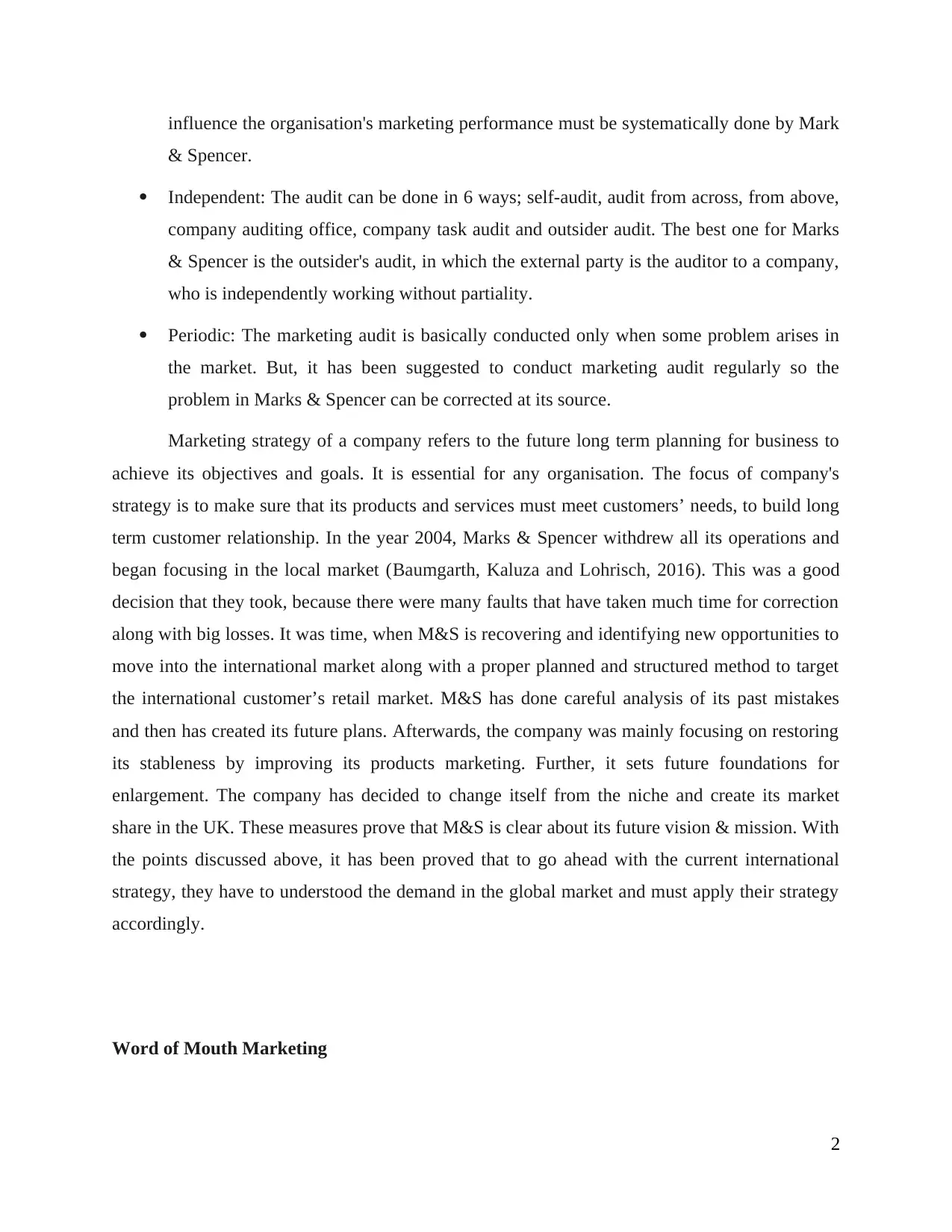
influence the organisation's marketing performance must be systematically done by Mark
& Spencer.
Independent: The audit can be done in 6 ways; self-audit, audit from across, from above,
company auditing office, company task audit and outsider audit. The best one for Marks
& Spencer is the outsider's audit, in which the external party is the auditor to a company,
who is independently working without partiality.
Periodic: The marketing audit is basically conducted only when some problem arises in
the market. But, it has been suggested to conduct marketing audit regularly so the
problem in Marks & Spencer can be corrected at its source.
Marketing strategy of a company refers to the future long term planning for business to
achieve its objectives and goals. It is essential for any organisation. The focus of company's
strategy is to make sure that its products and services must meet customers’ needs, to build long
term customer relationship. In the year 2004, Marks & Spencer withdrew all its operations and
began focusing in the local market (Baumgarth, Kaluza and Lohrisch, 2016). This was a good
decision that they took, because there were many faults that have taken much time for correction
along with big losses. It was time, when M&S is recovering and identifying new opportunities to
move into the international market along with a proper planned and structured method to target
the international customer’s retail market. M&S has done careful analysis of its past mistakes
and then has created its future plans. Afterwards, the company was mainly focusing on restoring
its stableness by improving its products marketing. Further, it sets future foundations for
enlargement. The company has decided to change itself from the niche and create its market
share in the UK. These measures prove that M&S is clear about its future vision & mission. With
the points discussed above, it has been proved that to go ahead with the current international
strategy, they have to understood the demand in the global market and must apply their strategy
accordingly.
Word of Mouth Marketing
2
& Spencer.
Independent: The audit can be done in 6 ways; self-audit, audit from across, from above,
company auditing office, company task audit and outsider audit. The best one for Marks
& Spencer is the outsider's audit, in which the external party is the auditor to a company,
who is independently working without partiality.
Periodic: The marketing audit is basically conducted only when some problem arises in
the market. But, it has been suggested to conduct marketing audit regularly so the
problem in Marks & Spencer can be corrected at its source.
Marketing strategy of a company refers to the future long term planning for business to
achieve its objectives and goals. It is essential for any organisation. The focus of company's
strategy is to make sure that its products and services must meet customers’ needs, to build long
term customer relationship. In the year 2004, Marks & Spencer withdrew all its operations and
began focusing in the local market (Baumgarth, Kaluza and Lohrisch, 2016). This was a good
decision that they took, because there were many faults that have taken much time for correction
along with big losses. It was time, when M&S is recovering and identifying new opportunities to
move into the international market along with a proper planned and structured method to target
the international customer’s retail market. M&S has done careful analysis of its past mistakes
and then has created its future plans. Afterwards, the company was mainly focusing on restoring
its stableness by improving its products marketing. Further, it sets future foundations for
enlargement. The company has decided to change itself from the niche and create its market
share in the UK. These measures prove that M&S is clear about its future vision & mission. With
the points discussed above, it has been proved that to go ahead with the current international
strategy, they have to understood the demand in the global market and must apply their strategy
accordingly.
Word of Mouth Marketing
2
Paraphrase This Document
Need a fresh take? Get an instant paraphrase of this document with our AI Paraphraser
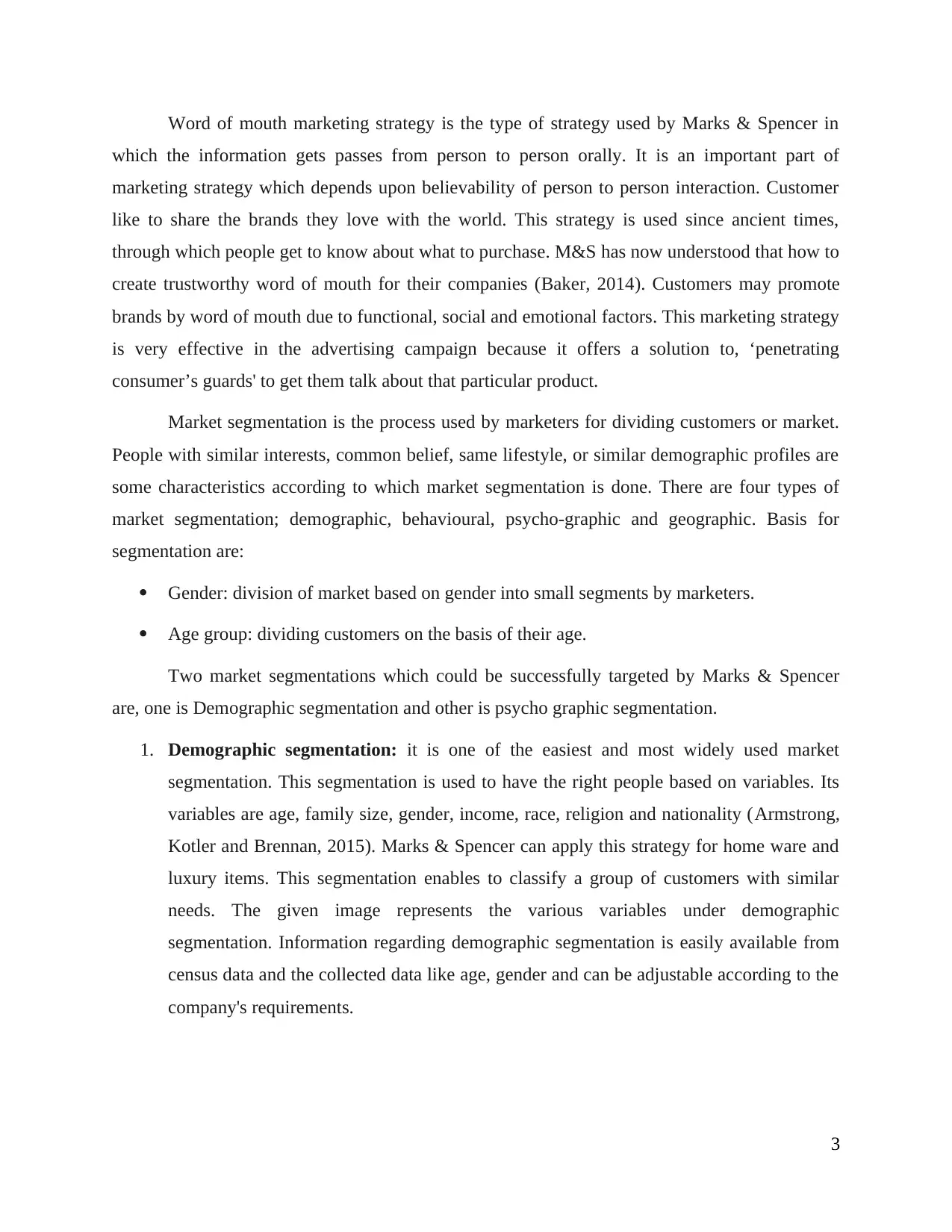
Word of mouth marketing strategy is the type of strategy used by Marks & Spencer in
which the information gets passes from person to person orally. It is an important part of
marketing strategy which depends upon believability of person to person interaction. Customer
like to share the brands they love with the world. This strategy is used since ancient times,
through which people get to know about what to purchase. M&S has now understood that how to
create trustworthy word of mouth for their companies (Baker, 2014). Customers may promote
brands by word of mouth due to functional, social and emotional factors. This marketing strategy
is very effective in the advertising campaign because it offers a solution to, ‘penetrating
consumer’s guards' to get them talk about that particular product.
Market segmentation is the process used by marketers for dividing customers or market.
People with similar interests, common belief, same lifestyle, or similar demographic profiles are
some characteristics according to which market segmentation is done. There are four types of
market segmentation; demographic, behavioural, psycho-graphic and geographic. Basis for
segmentation are:
Gender: division of market based on gender into small segments by marketers.
Age group: dividing customers on the basis of their age.
Two market segmentations which could be successfully targeted by Marks & Spencer
are, one is Demographic segmentation and other is psycho graphic segmentation.
1. Demographic segmentation: it is one of the easiest and most widely used market
segmentation. This segmentation is used to have the right people based on variables. Its
variables are age, family size, gender, income, race, religion and nationality (Armstrong,
Kotler and Brennan, 2015). Marks & Spencer can apply this strategy for home ware and
luxury items. This segmentation enables to classify a group of customers with similar
needs. The given image represents the various variables under demographic
segmentation. Information regarding demographic segmentation is easily available from
census data and the collected data like age, gender and can be adjustable according to the
company's requirements.
3
which the information gets passes from person to person orally. It is an important part of
marketing strategy which depends upon believability of person to person interaction. Customer
like to share the brands they love with the world. This strategy is used since ancient times,
through which people get to know about what to purchase. M&S has now understood that how to
create trustworthy word of mouth for their companies (Baker, 2014). Customers may promote
brands by word of mouth due to functional, social and emotional factors. This marketing strategy
is very effective in the advertising campaign because it offers a solution to, ‘penetrating
consumer’s guards' to get them talk about that particular product.
Market segmentation is the process used by marketers for dividing customers or market.
People with similar interests, common belief, same lifestyle, or similar demographic profiles are
some characteristics according to which market segmentation is done. There are four types of
market segmentation; demographic, behavioural, psycho-graphic and geographic. Basis for
segmentation are:
Gender: division of market based on gender into small segments by marketers.
Age group: dividing customers on the basis of their age.
Two market segmentations which could be successfully targeted by Marks & Spencer
are, one is Demographic segmentation and other is psycho graphic segmentation.
1. Demographic segmentation: it is one of the easiest and most widely used market
segmentation. This segmentation is used to have the right people based on variables. Its
variables are age, family size, gender, income, race, religion and nationality (Armstrong,
Kotler and Brennan, 2015). Marks & Spencer can apply this strategy for home ware and
luxury items. This segmentation enables to classify a group of customers with similar
needs. The given image represents the various variables under demographic
segmentation. Information regarding demographic segmentation is easily available from
census data and the collected data like age, gender and can be adjustable according to the
company's requirements.
3
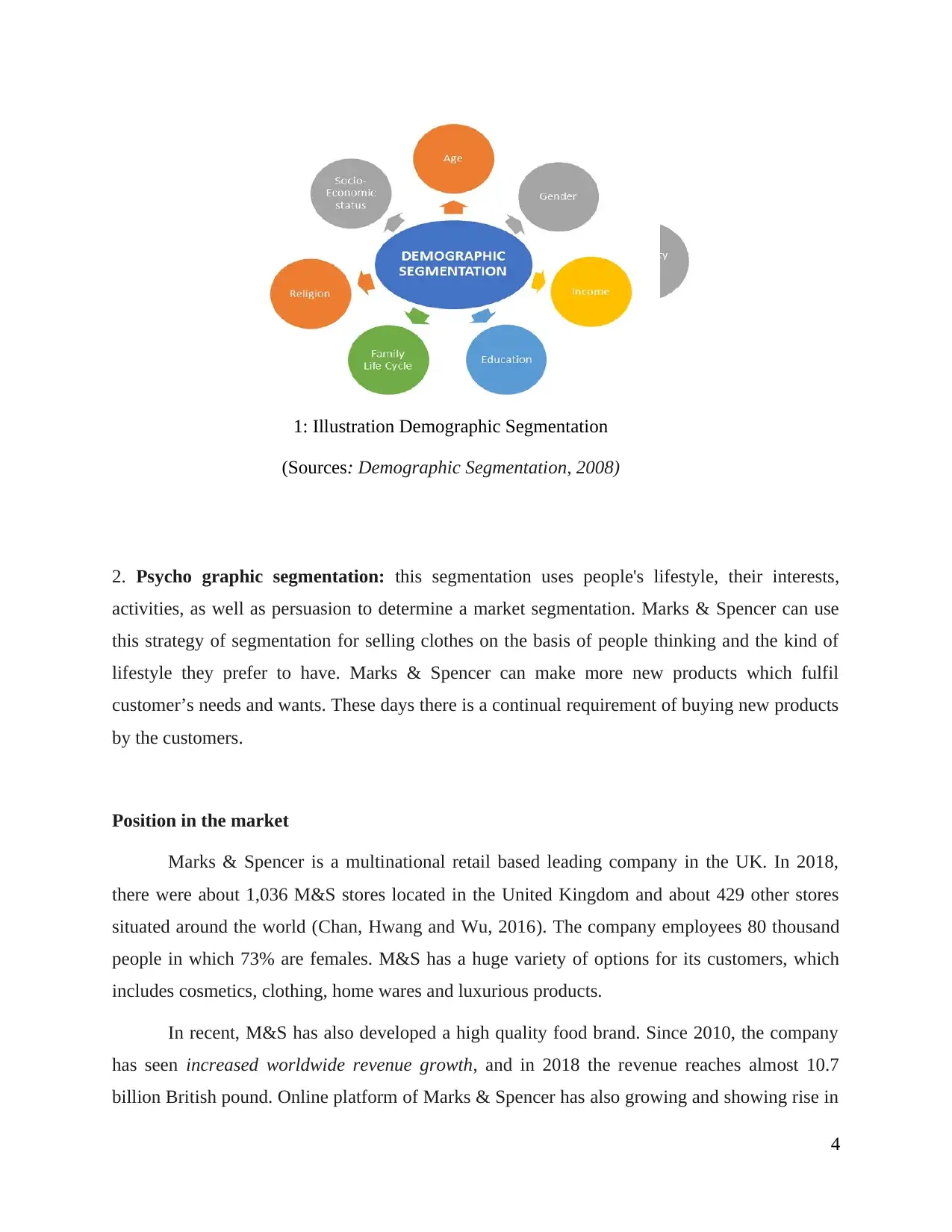
2. Psycho graphic segmentation: this segmentation uses people's lifestyle, their interests,
activities, as well as persuasion to determine a market segmentation. Marks & Spencer can use
this strategy of segmentation for selling clothes on the basis of people thinking and the kind of
lifestyle they prefer to have. Marks & Spencer can make more new products which fulfil
customer’s needs and wants. These days there is a continual requirement of buying new products
by the customers.
Position in the market
Marks & Spencer is a multinational retail based leading company in the UK. In 2018,
there were about 1,036 M&S stores located in the United Kingdom and about 429 other stores
situated around the world (Chan, Hwang and Wu, 2016). The company employees 80 thousand
people in which 73% are females. M&S has a huge variety of options for its customers, which
includes cosmetics, clothing, home wares and luxurious products.
In recent, M&S has also developed a high quality food brand. Since 2010, the company
has seen increased worldwide revenue growth, and in 2018 the revenue reaches almost 10.7
billion British pound. Online platform of Marks & Spencer has also growing and showing rise in
4
Illustration 2: Psycho graphic Segmentation
1: Illustration Demographic Segmentation
(Sources: Demographic Segmentation, 2008)
activities, as well as persuasion to determine a market segmentation. Marks & Spencer can use
this strategy of segmentation for selling clothes on the basis of people thinking and the kind of
lifestyle they prefer to have. Marks & Spencer can make more new products which fulfil
customer’s needs and wants. These days there is a continual requirement of buying new products
by the customers.
Position in the market
Marks & Spencer is a multinational retail based leading company in the UK. In 2018,
there were about 1,036 M&S stores located in the United Kingdom and about 429 other stores
situated around the world (Chan, Hwang and Wu, 2016). The company employees 80 thousand
people in which 73% are females. M&S has a huge variety of options for its customers, which
includes cosmetics, clothing, home wares and luxurious products.
In recent, M&S has also developed a high quality food brand. Since 2010, the company
has seen increased worldwide revenue growth, and in 2018 the revenue reaches almost 10.7
billion British pound. Online platform of Marks & Spencer has also growing and showing rise in
4
Illustration 2: Psycho graphic Segmentation
1: Illustration Demographic Segmentation
(Sources: Demographic Segmentation, 2008)
⊘ This is a preview!⊘
Do you want full access?
Subscribe today to unlock all pages.

Trusted by 1+ million students worldwide
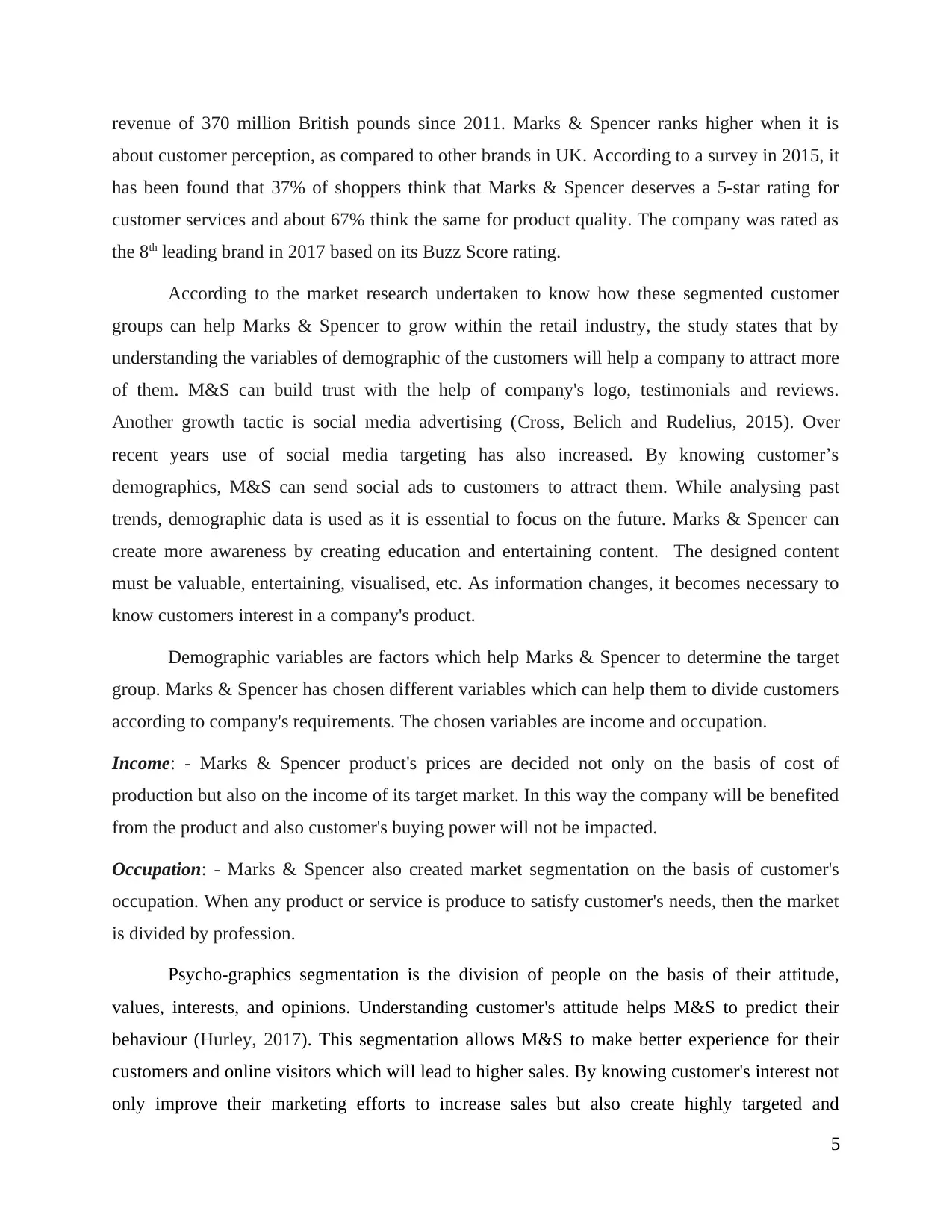
revenue of 370 million British pounds since 2011. Marks & Spencer ranks higher when it is
about customer perception, as compared to other brands in UK. According to a survey in 2015, it
has been found that 37% of shoppers think that Marks & Spencer deserves a 5-star rating for
customer services and about 67% think the same for product quality. The company was rated as
the 8th leading brand in 2017 based on its Buzz Score rating.
According to the market research undertaken to know how these segmented customer
groups can help Marks & Spencer to grow within the retail industry, the study states that by
understanding the variables of demographic of the customers will help a company to attract more
of them. M&S can build trust with the help of company's logo, testimonials and reviews.
Another growth tactic is social media advertising (Cross, Belich and Rudelius, 2015). Over
recent years use of social media targeting has also increased. By knowing customer’s
demographics, M&S can send social ads to customers to attract them. While analysing past
trends, demographic data is used as it is essential to focus on the future. Marks & Spencer can
create more awareness by creating education and entertaining content. The designed content
must be valuable, entertaining, visualised, etc. As information changes, it becomes necessary to
know customers interest in a company's product.
Demographic variables are factors which help Marks & Spencer to determine the target
group. Marks & Spencer has chosen different variables which can help them to divide customers
according to company's requirements. The chosen variables are income and occupation.
Income: - Marks & Spencer product's prices are decided not only on the basis of cost of
production but also on the income of its target market. In this way the company will be benefited
from the product and also customer's buying power will not be impacted.
Occupation: - Marks & Spencer also created market segmentation on the basis of customer's
occupation. When any product or service is produce to satisfy customer's needs, then the market
is divided by profession.
Psycho-graphics segmentation is the division of people on the basis of their attitude,
values, interests, and opinions. Understanding customer's attitude helps M&S to predict their
behaviour (Hurley, 2017). This segmentation allows M&S to make better experience for their
customers and online visitors which will lead to higher sales. By knowing customer's interest not
only improve their marketing efforts to increase sales but also create highly targeted and
5
about customer perception, as compared to other brands in UK. According to a survey in 2015, it
has been found that 37% of shoppers think that Marks & Spencer deserves a 5-star rating for
customer services and about 67% think the same for product quality. The company was rated as
the 8th leading brand in 2017 based on its Buzz Score rating.
According to the market research undertaken to know how these segmented customer
groups can help Marks & Spencer to grow within the retail industry, the study states that by
understanding the variables of demographic of the customers will help a company to attract more
of them. M&S can build trust with the help of company's logo, testimonials and reviews.
Another growth tactic is social media advertising (Cross, Belich and Rudelius, 2015). Over
recent years use of social media targeting has also increased. By knowing customer’s
demographics, M&S can send social ads to customers to attract them. While analysing past
trends, demographic data is used as it is essential to focus on the future. Marks & Spencer can
create more awareness by creating education and entertaining content. The designed content
must be valuable, entertaining, visualised, etc. As information changes, it becomes necessary to
know customers interest in a company's product.
Demographic variables are factors which help Marks & Spencer to determine the target
group. Marks & Spencer has chosen different variables which can help them to divide customers
according to company's requirements. The chosen variables are income and occupation.
Income: - Marks & Spencer product's prices are decided not only on the basis of cost of
production but also on the income of its target market. In this way the company will be benefited
from the product and also customer's buying power will not be impacted.
Occupation: - Marks & Spencer also created market segmentation on the basis of customer's
occupation. When any product or service is produce to satisfy customer's needs, then the market
is divided by profession.
Psycho-graphics segmentation is the division of people on the basis of their attitude,
values, interests, and opinions. Understanding customer's attitude helps M&S to predict their
behaviour (Hurley, 2017). This segmentation allows M&S to make better experience for their
customers and online visitors which will lead to higher sales. By knowing customer's interest not
only improve their marketing efforts to increase sales but also create highly targeted and
5
Paraphrase This Document
Need a fresh take? Get an instant paraphrase of this document with our AI Paraphraser
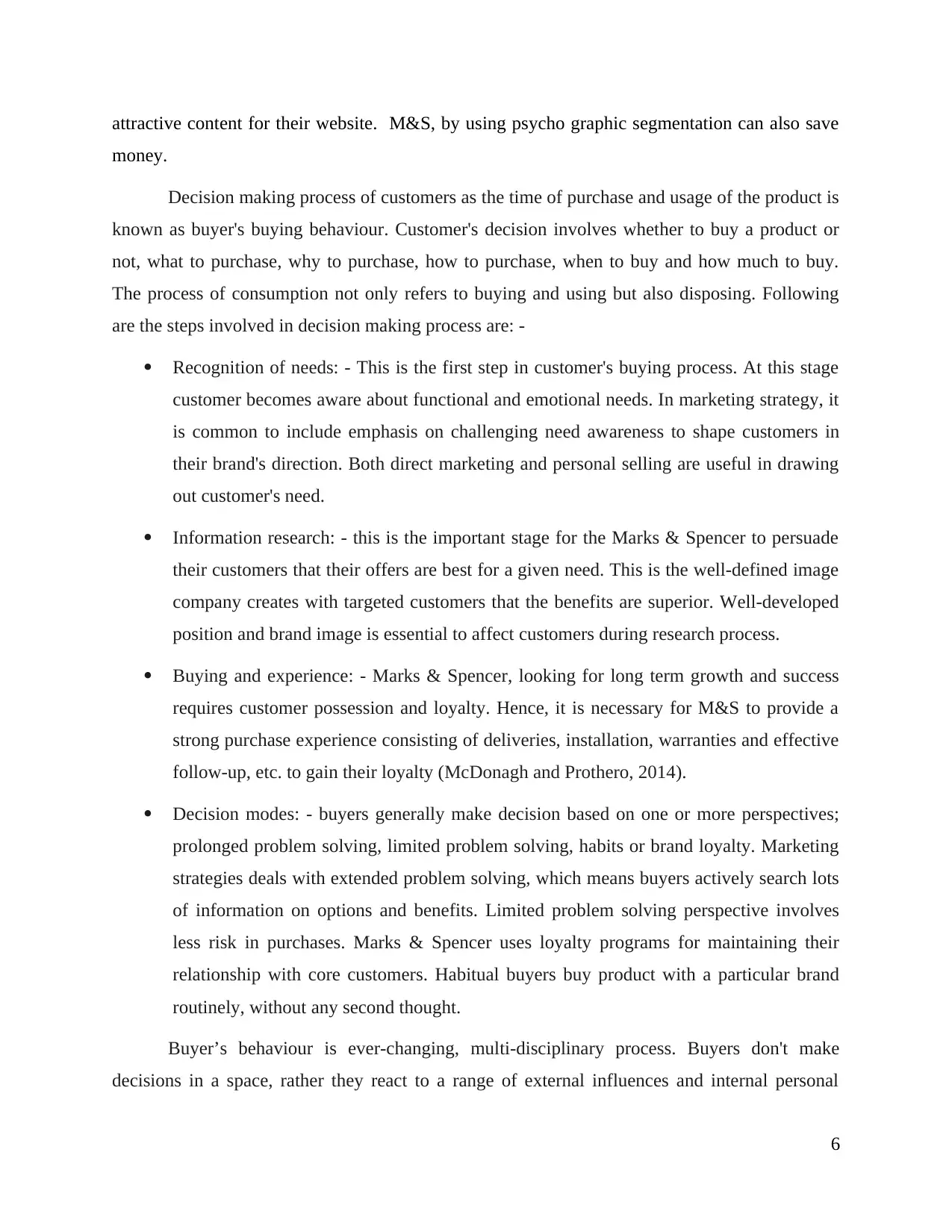
attractive content for their website. M&S, by using psycho graphic segmentation can also save
money.
Decision making process of customers as the time of purchase and usage of the product is
known as buyer's buying behaviour. Customer's decision involves whether to buy a product or
not, what to purchase, why to purchase, how to purchase, when to buy and how much to buy.
The process of consumption not only refers to buying and using but also disposing. Following
are the steps involved in decision making process are: -
Recognition of needs: - This is the first step in customer's buying process. At this stage
customer becomes aware about functional and emotional needs. In marketing strategy, it
is common to include emphasis on challenging need awareness to shape customers in
their brand's direction. Both direct marketing and personal selling are useful in drawing
out customer's need.
Information research: - this is the important stage for the Marks & Spencer to persuade
their customers that their offers are best for a given need. This is the well-defined image
company creates with targeted customers that the benefits are superior. Well-developed
position and brand image is essential to affect customers during research process.
Buying and experience: - Marks & Spencer, looking for long term growth and success
requires customer possession and loyalty. Hence, it is necessary for M&S to provide a
strong purchase experience consisting of deliveries, installation, warranties and effective
follow-up, etc. to gain their loyalty (McDonagh and Prothero, 2014).
Decision modes: - buyers generally make decision based on one or more perspectives;
prolonged problem solving, limited problem solving, habits or brand loyalty. Marketing
strategies deals with extended problem solving, which means buyers actively search lots
of information on options and benefits. Limited problem solving perspective involves
less risk in purchases. Marks & Spencer uses loyalty programs for maintaining their
relationship with core customers. Habitual buyers buy product with a particular brand
routinely, without any second thought.
Buyer’s behaviour is ever-changing, multi-disciplinary process. Buyers don't make
decisions in a space, rather they react to a range of external influences and internal personal
6
money.
Decision making process of customers as the time of purchase and usage of the product is
known as buyer's buying behaviour. Customer's decision involves whether to buy a product or
not, what to purchase, why to purchase, how to purchase, when to buy and how much to buy.
The process of consumption not only refers to buying and using but also disposing. Following
are the steps involved in decision making process are: -
Recognition of needs: - This is the first step in customer's buying process. At this stage
customer becomes aware about functional and emotional needs. In marketing strategy, it
is common to include emphasis on challenging need awareness to shape customers in
their brand's direction. Both direct marketing and personal selling are useful in drawing
out customer's need.
Information research: - this is the important stage for the Marks & Spencer to persuade
their customers that their offers are best for a given need. This is the well-defined image
company creates with targeted customers that the benefits are superior. Well-developed
position and brand image is essential to affect customers during research process.
Buying and experience: - Marks & Spencer, looking for long term growth and success
requires customer possession and loyalty. Hence, it is necessary for M&S to provide a
strong purchase experience consisting of deliveries, installation, warranties and effective
follow-up, etc. to gain their loyalty (McDonagh and Prothero, 2014).
Decision modes: - buyers generally make decision based on one or more perspectives;
prolonged problem solving, limited problem solving, habits or brand loyalty. Marketing
strategies deals with extended problem solving, which means buyers actively search lots
of information on options and benefits. Limited problem solving perspective involves
less risk in purchases. Marks & Spencer uses loyalty programs for maintaining their
relationship with core customers. Habitual buyers buy product with a particular brand
routinely, without any second thought.
Buyer’s behaviour is ever-changing, multi-disciplinary process. Buyers don't make
decisions in a space, rather they react to a range of external influences and internal personal
6
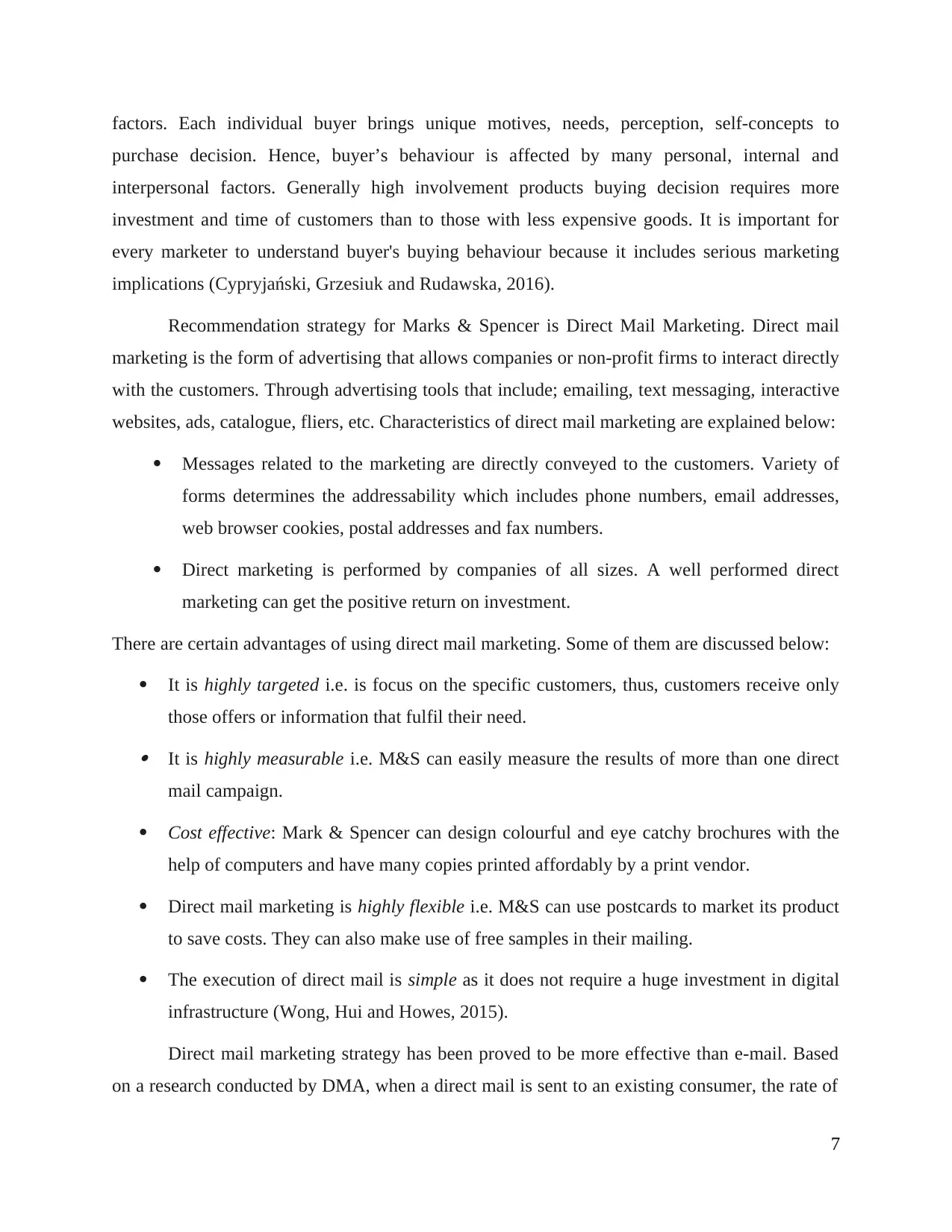
factors. Each individual buyer brings unique motives, needs, perception, self-concepts to
purchase decision. Hence, buyer’s behaviour is affected by many personal, internal and
interpersonal factors. Generally high involvement products buying decision requires more
investment and time of customers than to those with less expensive goods. It is important for
every marketer to understand buyer's buying behaviour because it includes serious marketing
implications (Cypryjański, Grzesiuk and Rudawska, 2016).
Recommendation strategy for Marks & Spencer is Direct Mail Marketing. Direct mail
marketing is the form of advertising that allows companies or non-profit firms to interact directly
with the customers. Through advertising tools that include; emailing, text messaging, interactive
websites, ads, catalogue, fliers, etc. Characteristics of direct mail marketing are explained below:
Messages related to the marketing are directly conveyed to the customers. Variety of
forms determines the addressability which includes phone numbers, email addresses,
web browser cookies, postal addresses and fax numbers.
Direct marketing is performed by companies of all sizes. A well performed direct
marketing can get the positive return on investment.
There are certain advantages of using direct mail marketing. Some of them are discussed below:
It is highly targeted i.e. is focus on the specific customers, thus, customers receive only
those offers or information that fulfil their need. It is highly measurable i.e. M&S can easily measure the results of more than one direct
mail campaign.
Cost effective: Mark & Spencer can design colourful and eye catchy brochures with the
help of computers and have many copies printed affordably by a print vendor.
Direct mail marketing is highly flexible i.e. M&S can use postcards to market its product
to save costs. They can also make use of free samples in their mailing.
The execution of direct mail is simple as it does not require a huge investment in digital
infrastructure (Wong, Hui and Howes, 2015).
Direct mail marketing strategy has been proved to be more effective than e-mail. Based
on a research conducted by DMA, when a direct mail is sent to an existing consumer, the rate of
7
purchase decision. Hence, buyer’s behaviour is affected by many personal, internal and
interpersonal factors. Generally high involvement products buying decision requires more
investment and time of customers than to those with less expensive goods. It is important for
every marketer to understand buyer's buying behaviour because it includes serious marketing
implications (Cypryjański, Grzesiuk and Rudawska, 2016).
Recommendation strategy for Marks & Spencer is Direct Mail Marketing. Direct mail
marketing is the form of advertising that allows companies or non-profit firms to interact directly
with the customers. Through advertising tools that include; emailing, text messaging, interactive
websites, ads, catalogue, fliers, etc. Characteristics of direct mail marketing are explained below:
Messages related to the marketing are directly conveyed to the customers. Variety of
forms determines the addressability which includes phone numbers, email addresses,
web browser cookies, postal addresses and fax numbers.
Direct marketing is performed by companies of all sizes. A well performed direct
marketing can get the positive return on investment.
There are certain advantages of using direct mail marketing. Some of them are discussed below:
It is highly targeted i.e. is focus on the specific customers, thus, customers receive only
those offers or information that fulfil their need. It is highly measurable i.e. M&S can easily measure the results of more than one direct
mail campaign.
Cost effective: Mark & Spencer can design colourful and eye catchy brochures with the
help of computers and have many copies printed affordably by a print vendor.
Direct mail marketing is highly flexible i.e. M&S can use postcards to market its product
to save costs. They can also make use of free samples in their mailing.
The execution of direct mail is simple as it does not require a huge investment in digital
infrastructure (Wong, Hui and Howes, 2015).
Direct mail marketing strategy has been proved to be more effective than e-mail. Based
on a research conducted by DMA, when a direct mail is sent to an existing consumer, the rate of
7
⊘ This is a preview!⊘
Do you want full access?
Subscribe today to unlock all pages.

Trusted by 1+ million students worldwide
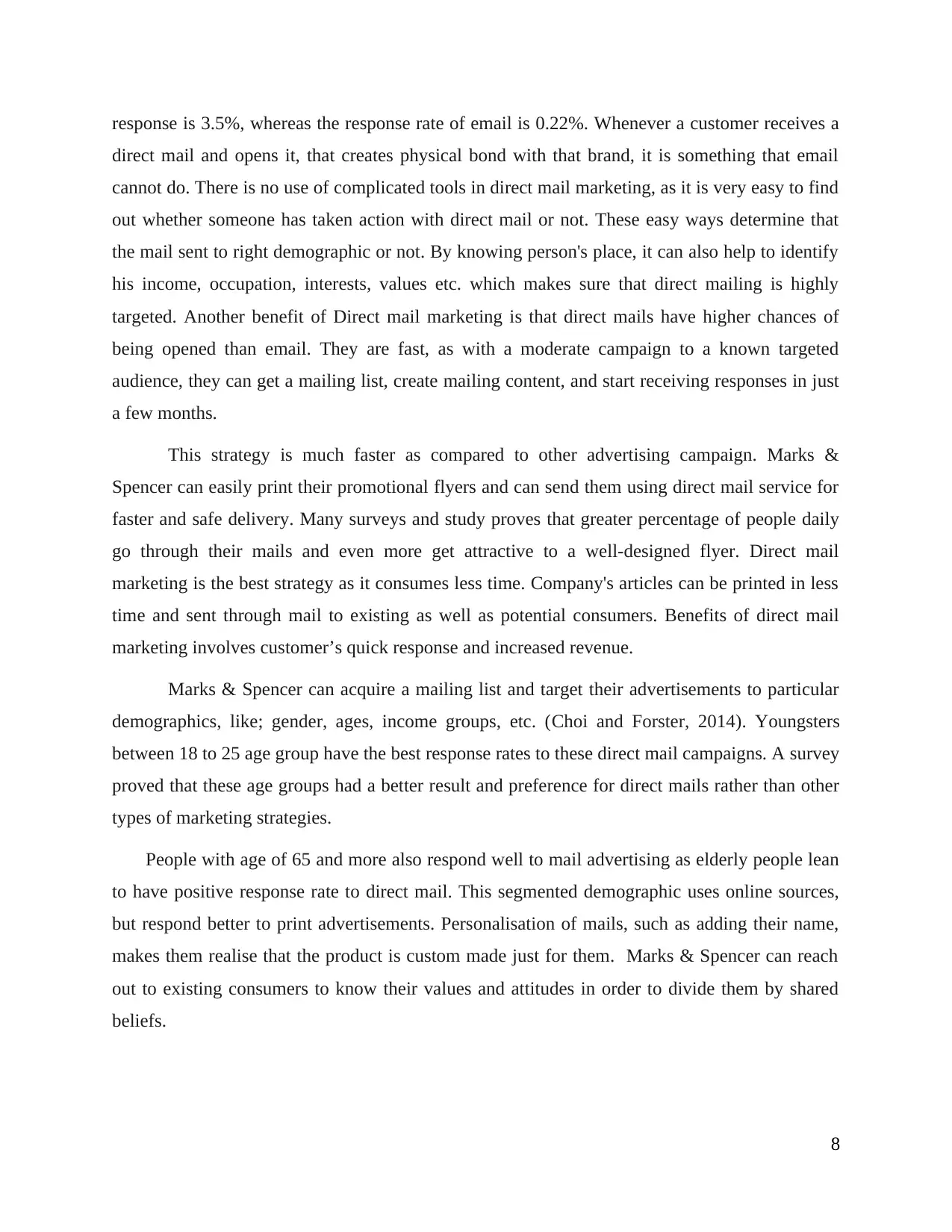
response is 3.5%, whereas the response rate of email is 0.22%. Whenever a customer receives a
direct mail and opens it, that creates physical bond with that brand, it is something that email
cannot do. There is no use of complicated tools in direct mail marketing, as it is very easy to find
out whether someone has taken action with direct mail or not. These easy ways determine that
the mail sent to right demographic or not. By knowing person's place, it can also help to identify
his income, occupation, interests, values etc. which makes sure that direct mailing is highly
targeted. Another benefit of Direct mail marketing is that direct mails have higher chances of
being opened than email. They are fast, as with a moderate campaign to a known targeted
audience, they can get a mailing list, create mailing content, and start receiving responses in just
a few months.
This strategy is much faster as compared to other advertising campaign. Marks &
Spencer can easily print their promotional flyers and can send them using direct mail service for
faster and safe delivery. Many surveys and study proves that greater percentage of people daily
go through their mails and even more get attractive to a well-designed flyer. Direct mail
marketing is the best strategy as it consumes less time. Company's articles can be printed in less
time and sent through mail to existing as well as potential consumers. Benefits of direct mail
marketing involves customer’s quick response and increased revenue.
Marks & Spencer can acquire a mailing list and target their advertisements to particular
demographics, like; gender, ages, income groups, etc. (Choi and Forster, 2014). Youngsters
between 18 to 25 age group have the best response rates to these direct mail campaigns. A survey
proved that these age groups had a better result and preference for direct mails rather than other
types of marketing strategies.
People with age of 65 and more also respond well to mail advertising as elderly people lean
to have positive response rate to direct mail. This segmented demographic uses online sources,
but respond better to print advertisements. Personalisation of mails, such as adding their name,
makes them realise that the product is custom made just for them. Marks & Spencer can reach
out to existing consumers to know their values and attitudes in order to divide them by shared
beliefs.
8
direct mail and opens it, that creates physical bond with that brand, it is something that email
cannot do. There is no use of complicated tools in direct mail marketing, as it is very easy to find
out whether someone has taken action with direct mail or not. These easy ways determine that
the mail sent to right demographic or not. By knowing person's place, it can also help to identify
his income, occupation, interests, values etc. which makes sure that direct mailing is highly
targeted. Another benefit of Direct mail marketing is that direct mails have higher chances of
being opened than email. They are fast, as with a moderate campaign to a known targeted
audience, they can get a mailing list, create mailing content, and start receiving responses in just
a few months.
This strategy is much faster as compared to other advertising campaign. Marks &
Spencer can easily print their promotional flyers and can send them using direct mail service for
faster and safe delivery. Many surveys and study proves that greater percentage of people daily
go through their mails and even more get attractive to a well-designed flyer. Direct mail
marketing is the best strategy as it consumes less time. Company's articles can be printed in less
time and sent through mail to existing as well as potential consumers. Benefits of direct mail
marketing involves customer’s quick response and increased revenue.
Marks & Spencer can acquire a mailing list and target their advertisements to particular
demographics, like; gender, ages, income groups, etc. (Choi and Forster, 2014). Youngsters
between 18 to 25 age group have the best response rates to these direct mail campaigns. A survey
proved that these age groups had a better result and preference for direct mails rather than other
types of marketing strategies.
People with age of 65 and more also respond well to mail advertising as elderly people lean
to have positive response rate to direct mail. This segmented demographic uses online sources,
but respond better to print advertisements. Personalisation of mails, such as adding their name,
makes them realise that the product is custom made just for them. Marks & Spencer can reach
out to existing consumers to know their values and attitudes in order to divide them by shared
beliefs.
8
Paraphrase This Document
Need a fresh take? Get an instant paraphrase of this document with our AI Paraphraser
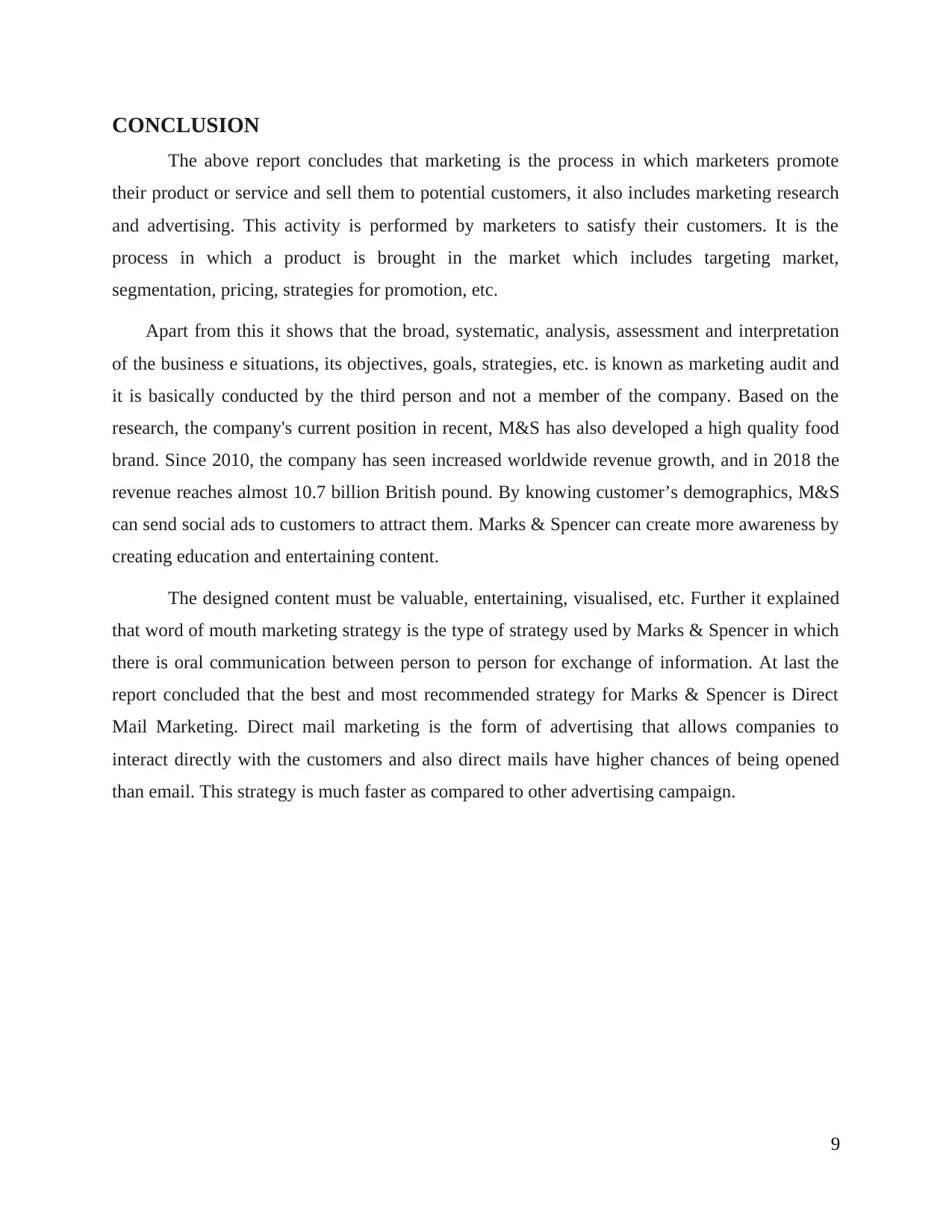
CONCLUSION
The above report concludes that marketing is the process in which marketers promote
their product or service and sell them to potential customers, it also includes marketing research
and advertising. This activity is performed by marketers to satisfy their customers. It is the
process in which a product is brought in the market which includes targeting market,
segmentation, pricing, strategies for promotion, etc.
Apart from this it shows that the broad, systematic, analysis, assessment and interpretation
of the business e situations, its objectives, goals, strategies, etc. is known as marketing audit and
it is basically conducted by the third person and not a member of the company. Based on the
research, the company's current position in recent, M&S has also developed a high quality food
brand. Since 2010, the company has seen increased worldwide revenue growth, and in 2018 the
revenue reaches almost 10.7 billion British pound. By knowing customer’s demographics, M&S
can send social ads to customers to attract them. Marks & Spencer can create more awareness by
creating education and entertaining content.
The designed content must be valuable, entertaining, visualised, etc. Further it explained
that word of mouth marketing strategy is the type of strategy used by Marks & Spencer in which
there is oral communication between person to person for exchange of information. At last the
report concluded that the best and most recommended strategy for Marks & Spencer is Direct
Mail Marketing. Direct mail marketing is the form of advertising that allows companies to
interact directly with the customers and also direct mails have higher chances of being opened
than email. This strategy is much faster as compared to other advertising campaign.
9
The above report concludes that marketing is the process in which marketers promote
their product or service and sell them to potential customers, it also includes marketing research
and advertising. This activity is performed by marketers to satisfy their customers. It is the
process in which a product is brought in the market which includes targeting market,
segmentation, pricing, strategies for promotion, etc.
Apart from this it shows that the broad, systematic, analysis, assessment and interpretation
of the business e situations, its objectives, goals, strategies, etc. is known as marketing audit and
it is basically conducted by the third person and not a member of the company. Based on the
research, the company's current position in recent, M&S has also developed a high quality food
brand. Since 2010, the company has seen increased worldwide revenue growth, and in 2018 the
revenue reaches almost 10.7 billion British pound. By knowing customer’s demographics, M&S
can send social ads to customers to attract them. Marks & Spencer can create more awareness by
creating education and entertaining content.
The designed content must be valuable, entertaining, visualised, etc. Further it explained
that word of mouth marketing strategy is the type of strategy used by Marks & Spencer in which
there is oral communication between person to person for exchange of information. At last the
report concluded that the best and most recommended strategy for Marks & Spencer is Direct
Mail Marketing. Direct mail marketing is the form of advertising that allows companies to
interact directly with the customers and also direct mails have higher chances of being opened
than email. This strategy is much faster as compared to other advertising campaign.
9
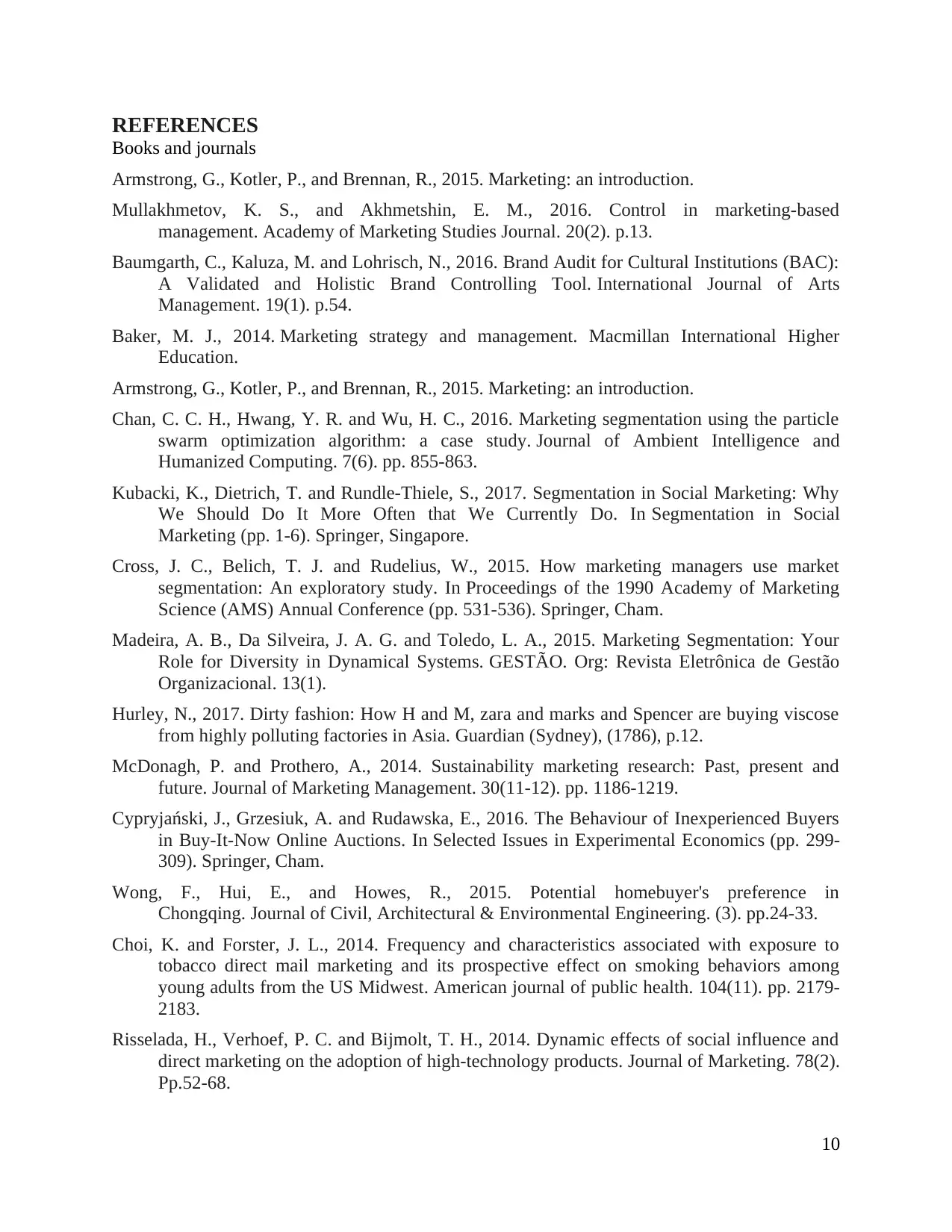
REFERENCES
Books and journals
Armstrong, G., Kotler, P., and Brennan, R., 2015. Marketing: an introduction.
Mullakhmetov, K. S., and Akhmetshin, E. M., 2016. Control in marketing-based
management. Academy of Marketing Studies Journal. 20(2). p.13.
Baumgarth, C., Kaluza, M. and Lohrisch, N., 2016. Brand Audit for Cultural Institutions (BAC):
A Validated and Holistic Brand Controlling Tool. International Journal of Arts
Management. 19(1). p.54.
Baker, M. J., 2014. Marketing strategy and management. Macmillan International Higher
Education.
Armstrong, G., Kotler, P., and Brennan, R., 2015. Marketing: an introduction.
Chan, C. C. H., Hwang, Y. R. and Wu, H. C., 2016. Marketing segmentation using the particle
swarm optimization algorithm: a case study. Journal of Ambient Intelligence and
Humanized Computing. 7(6). pp. 855-863.
Kubacki, K., Dietrich, T. and Rundle-Thiele, S., 2017. Segmentation in Social Marketing: Why
We Should Do It More Often that We Currently Do. In Segmentation in Social
Marketing (pp. 1-6). Springer, Singapore.
Cross, J. C., Belich, T. J. and Rudelius, W., 2015. How marketing managers use market
segmentation: An exploratory study. In Proceedings of the 1990 Academy of Marketing
Science (AMS) Annual Conference (pp. 531-536). Springer, Cham.
Madeira, A. B., Da Silveira, J. A. G. and Toledo, L. A., 2015. Marketing Segmentation: Your
Role for Diversity in Dynamical Systems. GESTÃO. Org: Revista Eletrônica de Gestão
Organizacional. 13(1).
Hurley, N., 2017. Dirty fashion: How H and M, zara and marks and Spencer are buying viscose
from highly polluting factories in Asia. Guardian (Sydney), (1786), p.12.
McDonagh, P. and Prothero, A., 2014. Sustainability marketing research: Past, present and
future. Journal of Marketing Management. 30(11-12). pp. 1186-1219.
Cypryjański, J., Grzesiuk, A. and Rudawska, E., 2016. The Behaviour of Inexperienced Buyers
in Buy-It-Now Online Auctions. In Selected Issues in Experimental Economics (pp. 299-
309). Springer, Cham.
Wong, F., Hui, E., and Howes, R., 2015. Potential homebuyer's preference in
Chongqing. Journal of Civil, Architectural & Environmental Engineering. (3). pp.24-33.
Choi, K. and Forster, J. L., 2014. Frequency and characteristics associated with exposure to
tobacco direct mail marketing and its prospective effect on smoking behaviors among
young adults from the US Midwest. American journal of public health. 104(11). pp. 2179-
2183.
Risselada, H., Verhoef, P. C. and Bijmolt, T. H., 2014. Dynamic effects of social influence and
direct marketing on the adoption of high-technology products. Journal of Marketing. 78(2).
Pp.52-68.
10
Books and journals
Armstrong, G., Kotler, P., and Brennan, R., 2015. Marketing: an introduction.
Mullakhmetov, K. S., and Akhmetshin, E. M., 2016. Control in marketing-based
management. Academy of Marketing Studies Journal. 20(2). p.13.
Baumgarth, C., Kaluza, M. and Lohrisch, N., 2016. Brand Audit for Cultural Institutions (BAC):
A Validated and Holistic Brand Controlling Tool. International Journal of Arts
Management. 19(1). p.54.
Baker, M. J., 2014. Marketing strategy and management. Macmillan International Higher
Education.
Armstrong, G., Kotler, P., and Brennan, R., 2015. Marketing: an introduction.
Chan, C. C. H., Hwang, Y. R. and Wu, H. C., 2016. Marketing segmentation using the particle
swarm optimization algorithm: a case study. Journal of Ambient Intelligence and
Humanized Computing. 7(6). pp. 855-863.
Kubacki, K., Dietrich, T. and Rundle-Thiele, S., 2017. Segmentation in Social Marketing: Why
We Should Do It More Often that We Currently Do. In Segmentation in Social
Marketing (pp. 1-6). Springer, Singapore.
Cross, J. C., Belich, T. J. and Rudelius, W., 2015. How marketing managers use market
segmentation: An exploratory study. In Proceedings of the 1990 Academy of Marketing
Science (AMS) Annual Conference (pp. 531-536). Springer, Cham.
Madeira, A. B., Da Silveira, J. A. G. and Toledo, L. A., 2015. Marketing Segmentation: Your
Role for Diversity in Dynamical Systems. GESTÃO. Org: Revista Eletrônica de Gestão
Organizacional. 13(1).
Hurley, N., 2017. Dirty fashion: How H and M, zara and marks and Spencer are buying viscose
from highly polluting factories in Asia. Guardian (Sydney), (1786), p.12.
McDonagh, P. and Prothero, A., 2014. Sustainability marketing research: Past, present and
future. Journal of Marketing Management. 30(11-12). pp. 1186-1219.
Cypryjański, J., Grzesiuk, A. and Rudawska, E., 2016. The Behaviour of Inexperienced Buyers
in Buy-It-Now Online Auctions. In Selected Issues in Experimental Economics (pp. 299-
309). Springer, Cham.
Wong, F., Hui, E., and Howes, R., 2015. Potential homebuyer's preference in
Chongqing. Journal of Civil, Architectural & Environmental Engineering. (3). pp.24-33.
Choi, K. and Forster, J. L., 2014. Frequency and characteristics associated with exposure to
tobacco direct mail marketing and its prospective effect on smoking behaviors among
young adults from the US Midwest. American journal of public health. 104(11). pp. 2179-
2183.
Risselada, H., Verhoef, P. C. and Bijmolt, T. H., 2014. Dynamic effects of social influence and
direct marketing on the adoption of high-technology products. Journal of Marketing. 78(2).
Pp.52-68.
10
⊘ This is a preview!⊘
Do you want full access?
Subscribe today to unlock all pages.

Trusted by 1+ million students worldwide
1 out of 13
Related Documents
Your All-in-One AI-Powered Toolkit for Academic Success.
+13062052269
info@desklib.com
Available 24*7 on WhatsApp / Email
![[object Object]](/_next/static/media/star-bottom.7253800d.svg)
Unlock your academic potential
Copyright © 2020–2025 A2Z Services. All Rights Reserved. Developed and managed by ZUCOL.





